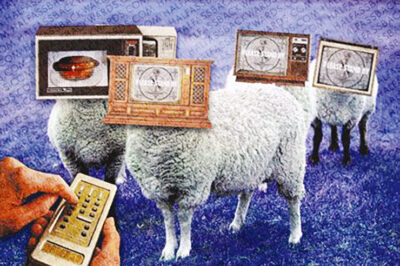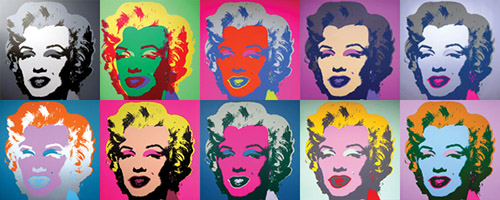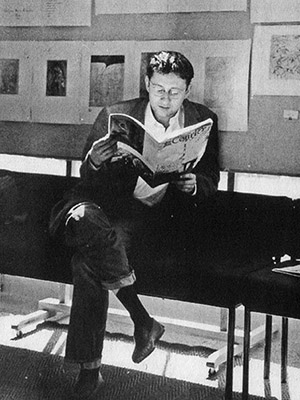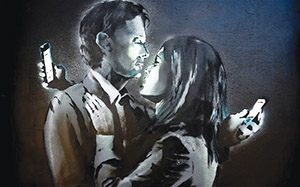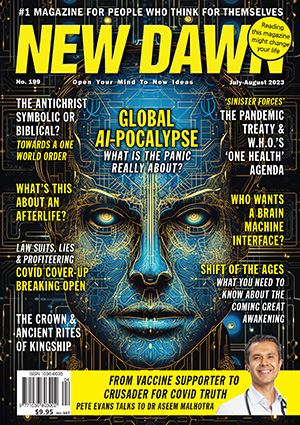From New Dawn 199 (Jul-Aug 2023)
It must be said that postmodern philosophy has not received the best PR. As soon as people hear the names Foucault, Deleuze, Derrida and Debord, they predictably roll their eyes, expecting some pretentious spiel about the relative nature of truth, knowledge and morality.
However, post-modern discourse provides valuable insight into the ‘high weirdness’ of contemporary culture, where nothing truly seems real and traditional systems of social order have begun to crumble away.
As the mainstream media ideologically distorts and occludes reality, and big-tech companies rigorously censor alternative information (while ‘hilarious’ videos of cats falling over accumulate millions of views), it appears that there is no reality beyond that which we see through our television screens, mobiles and tablets – a world of artificial simulation and dissimulation.
Even the politicians, in whom we blindly place our faith and trust, have no regard for the truth since the very concept of ‘truth’ has become redundant in an age of fake news, viral marketing and social algorithms. In a telling interview, when US presidential candidate Donald Trump was confronted about an error in the statistics he presented about race-based violent crimes, he merely replied, “all I know is what is on the internet.”1
As Dr Kane X. Faucher observes, “This kind of chamber or echo-effect of selective exposure is highly problematic for a variety of reasons, not least of which being that confirmation bias has an impact on decision-making and the possibly narrow or distorted worldview one may embrace. When it comes to what people choose to believe, this may also be on account of the narrow selective process of hidden algorithms. The tautological nature of the spectacle’s ‘truth’ forecloses the possibility of seeking beyond it to mount a significant or resonant challenge.”2
As social media sites subtly manipulate our political opinions, biases and assumptions, recommending certain content based on algorithmic prediction and selection, it becomes increasingly difficult to distinguish fact from fiction, truth from illusion, particularly when information has become the most priceless commodity – a substitution for the real itself.
How did we find ourselves in this hallucinatory, post-truth world where representation has replaced reality? Can the very notion of truth ever be resuscitated in a technocratic society where the boundary between the real and the imaginary has dissolved into thin air?
By turning to the postmodern thinkers of the 21st century, we can better understand why we now find ourselves in an uncanny world of simulation and simulacra – a world where the map precedes the territory.3
Baudrillard, Debord & the Society of the Spectacle
Since the late nineteenth century, with the rise of mass production and industrialism, the symbolic value of commodities has superseded their functionality as consumers invest in a particular identity or lifestyle. For example, when I purchase a Mercedes car, I am not only investing in a functional object which will transport me from one place to another but a status symbol associated with ideas of luxury, comfort and innovation.
As the French sociologist, philosopher and poet Jean Baudrillard observed, modern society is characterised by the emergence of a sign economy, in which commodities become increasingly disconnected from the physical world:
…use value is itself produced as a sign (and is not a fundamental truth) to help keep consumption going and the consumer society in business. In the fetishised realm of consumption, objects are misrecognised everywhere as being endowed with forces like “happiness, health, security, etc.” We see this so much that we forget that “what we are dealing with first is signs: a generalised codes of signs, a totally arbitrary code of differences, and it is on this basis, and not on account of their use values or their innate ‘virtues’, that objects exercise their fascination.”4
In other words, a commodity only acquires value through its differential relation to other signs rather than its intrinsic usefulness. The Mercedes car is no more luxurious than other vehicles on the market, but the company has distinguished itself by creating a brand image of luxury, comfort and innovation – social concepts which have no existence beyond their symbolic differentiation. In this sense, the sign economy functions as an entirely self-referential (or tautological) system (similar to the structure of language, where words are defined by other words, in a prison of the referential) in which consumers exchange capital (which in itself has no intrinsic value) for a particular sign or symbol, which has no instrumental function beyond the symbolic system which produces it.
As Baudrillard explained in Simulation and Simulacrum (1981), ever since the emergence of photography, radio, cinema, television and other replicative technologies, reality has been incrementally replaced by the representational to the point that we can no longer distinguish between original and copy.
As modern consumers are force-fed images of violence, sex and celebrity, they become so divorced from the physical world that they enter a virtual reality – that which Baudrillard terms the hyperreal:
Today, the history that is “given back” to us (precisely because it was taken from us) has no more of a relation to a “historical real” than neofiguration in painting does to the classical figuration of the real. Neofiguration is an invocation of resemblance, but at the same time the flagrant proof of the disappearance of objects in their very representation: hyperreal.5
The German philosopher Walter Benjamin, in The Work of Art in the Age of Mechanical Reproduction, similarly suggests that mass production not only replicates the physical but replaces it, transforming reality into hyper-mimetic simulacra:
What shrinks in an age where the work of art can be reproduced by technological means is its aura. The process is symptomatic; its significance points beyond the realm of art. Reproductive technology… removes the thing reproduced from the realm of tradition. In making many copies of the reproduction, it substitutes for its unique incidence a multiplicity of incidences.6
The copy is duplicated so many times that we cannot even speak of an original since reality itself has become the reconstruction of a reconstruction, without beginning or end, existing in a timeless present.
Take Andy Warhol’s infamous Marilyn Monroe print. The public has a certain perception of the actress based on the iconography of cinema and television, and she was photographed in such a manner as to maintain this two-dimensional stereotype. This photograph is then transformed into an artistic (or aesthetic) image and sold for millions of dollars, never once leaving the realm of symbolic representation. In a sense, there is no Marilyn Monroe, only the replicated images we see of her plastered across posters, keyrings, coffee cups and other fetishistic memorabilia, where she becomes the copy of a copy, the replica of a replica, entirely disembodied from the real.
However, in the age of post-modernity, where information is the most priceless commodity, the sign economy becomes uncannily spectral (and even phantasmagoric) in its non-being – an empty vacuum in which texts, images and videos endlessly circulate as if they were physical objects, even when they have no external phenomenality or dasein.
As the social media machine steadily encroaches upon our daily lives and so-called ‘influencers’ dominate the cultural zeitgeist, we become passive spectators, gawping over the latest Instagram image with 100,000 likes. While technology provides the illusion of active participation and social collaboration, in actuality, it turns us into informational consumers, entirely disconnected from the physical world.
As Faucher notes, “Digital representation becomes the active process and product of this milieu, a hyperreal environment that subordinates the now impoverished value of the non-digital to the production of images that are destined for digital re-production of images that are destined for digital re-production. The network spectacle is presented as unassailably good, perfect, and the primary source of the positively represented values decanted from neoliberalism such as efficiency, speed and connectivity. However, it is those very values that not only speak directly to issues of exchange value and commodity fetishism, but also physically impoverishes those who labour to support the spectacle.”7
As we docilely gaze at Instagram images of photoshopped models standing next to lavish sports cars with pseudo-philosophical quotes about ‘living your dreams’, we forget that a multinational infrastructure based on the exploitation of the poorest countries has been set up in order to feed our insatiable technological addiction. When we stare into the black mirror of our iPhones, we rarely think about the raw materials, sweatshop manufacture and precarious work required to keep this system in motion. The exploitation remains firmly hidden from view, keeping us ignorant as to its true economic and environmental effects. The Spectacle becomes the only knowable ‘reality’.
The French philosopher, film-maker and Situationist, Guy Debord, foresaw the emergence of spectacular society in which the general public passively consumes texts and images with detached fascination rather than actively participating in a vibrant culture. As he observes, in Society of the Spectacle (1967), everything “that was directly lived has moved away into representation.”8
In regard to political history, we remain barred from the past since time itself has entered the realm of the representational, and these representations are manufactured, designed and assembled by the Spectacle itself. The mainstream media functions as nothing more than a tautological system of informational input and output, continually referencing its own self-fabricated mythologies, narratives and constructions.
Debord stated: “The Spectacle proves its arguments simply by going round in circles: by coming back to the start, by repetition, by constant reaffirmation in the only space left where anything can be publicly affirmed, and believed, precisely because that is the only thing to which everyone is a witness.”9
Our understanding of the past has no existence outside the lens of the media, distorting, fabricating and occluding reality as we know it. Take a film like Apocalypse Now. Here, we see the cinematic representation (not to be mistaken for mere replication) of a historical event, manufactured for mass consumption, which in itself is the reconstruction of a reconstruction – a war that was televised, cinematised and narrativized to present a certain version (or model) of history. This is not to suggest that the Vietnam War never happened. On the contrary, it was a bloody and detestable conflict in which thousands upon thousands of innocent people were killed in the name of capitalist economics. But since the public’s perception of the war was always interfaced through the eye of the camera, it had no meaning beyond the screen and therefore could be replicated as replica without the real ever rearing its ugly head.
Online Petitions, Virtue Signalling & the Politics of the Spectacle
In our societies of the Spectacle, political engagement becomes increasingly tokenistic, a way of providing the public with a false sense of autonomy, even as the techno-industrial machine subtly silences voices of dissidence, subversion and resistance.
Politics is nothing more than a theatrical drama in which public and private actors take to the stage, ‘looking good’ for the cameras, making reference to abstract ideals such as the ‘national interest,’ ‘international cooperation’ and ‘economic growth’ in order to win the hearts and minds of voters.
It is no coincidence that many politicians – including most famously the 40th president of the US, Ronald Reagan – have close ties to Hollywood. As Paul Virilio observes in War and Cinema, politics is now a form of entertainment and vice versa – a circus act designed to keep the masses in a state of docile complacency, with no real way of changing the system.10
Social media has ‘spectacularised’ political engagement in new and even more dangerous ways since it digitally empowers online users yet alienates them from the physical world, becoming nothing more than the simulation of a simulation.
Anyone can go on Twitter and post a 140-character tweet about Jeffrey Epstein’s ‘suicide’ or the Prince Andrew scandal, but what is the result of such anger and frustration? It merely exists inside an empty vacuum – an artificial reality – where information endlessly circulates, generating more and more content, while the dominant cultural paradigm remains untouched, unharmed and unscarred.
Thus, we now see the rise of the ‘virtue-signalling’ culture in which individuals openly criticise corporate exploitation, media misrepresentation and governmental corruption, even as they support the very institutional systems they verbally disparage. The proliferation of virtue signalling – in which people attempt to win praise for showing support for a social cause without actually doing anything meaningful to advance it – is a predictable outcome of the Spectacle.
Of course, it would be inaccurate to suggest that online discourse has no impact on the real world. When the Black Lives Matter Movement urged disenfranchised minorities to take to the streets and protest against police brutality, the internet was key in organising local demonstrations, rallies and marches. Yet, even then, the movement became a mere spectacle – a televised form of entertainment – reappropriated by the mainstream media in order to maximise its informational output.
As Baudrillard astutely observed, that which begins in the world of simulacra inevitably ends in the world of simulacra since there is no external reality to even reference.
This is why today we see the emergence of a ‘petition culture’ in which a disillusioned public tries to bring about meaningful change by signing online petitions, many of which never even reach the ears of the political establishment.
In the United Kingdom, Parliament is obliged to discuss a petition if it receives enough signatures, however these political processes are entirely theatrical – a psychodrama ritual – designed to give the illusion of democratic engagement (while the puppet masters pulling the strings remain occluded in the shadows). Thousands of people could sign a petition requesting a public inquiry into the many documents which have gone missing that implicate prominent British politicians in cases of child abuse and sex trafficking, but it would not make any difference – the game has ended before it even began.
Furthermore, many of the political issues which are brought before Parliament, such as the ‘energy crisis’ and the ‘cost of living’, are carefully engineered by the mainstream media in order to create problems to which the state has a solution, establishing a pretext for further governmental intervention and control.
Take the ‘living crisis’. Many people are urging national governments to take immediate action and implement a universal basic income, which supports the poorest in our society. However, while there is no denying that the global economy is in big trouble, the economy itself (which never leaves the hermetic realm of sign, symbol and simulation) is never brought under scrutiny – it remains a constant a priori. Moreover, there is no discussion on how a universal income would be implemented, who would control it, or whether it would lead to new forms of economic regulation (such as a social credit scoring system).
This is exactly how the simulacra functions – it provides ‘false’ solutions to ‘false’ problems within a ‘false’ system based on a ‘false’ currency, blurring the boundary between the real and the representational to the extent that the latter replaces the former. The modern Spectacle is so overwhelming in its hyper-mimetic power that we cannot even speak of an external reality where meaningful political change can be actualised – the medium has now become the message.
The profound sense of alienation, disillusionment and unreality that many of us experience in today’s ‘post-truth’ culture cannot be understood as a historically isolated phenomenon but an eschatological climax – a technological singularity – where the simulation has finally replaced the real.
Even a film like The Matrix does not encapsulate the hallucinatory nightmare of modern civilisation, since at least there was the possibility of escaping Plato’s cave, a division between reality and illusion; in today’s digital age, we awake from the simulacra only to find ourselves in another simulation, unable to break free from the prison of the referential.
Our culture will only become stranger once virtual reality technologies become increasingly advanced in their power to deceive and replace a world that never existed in the first place. As everything that is solid melts into thin air, all that remains is a dream inside a dream – a holographic universe where reality itself is but a spectral ghost of the past.
Footnotes
1. K. Faucher, (2018), Social Capital Online, University of Westminster Press, 115
2. Ibid.
3. J. Baudrillard, (1994), Simulacra and Simulation, Michigan University Press
4. J. Baudrillard, (2019), For a Critique of the Political Economy of the Sign, Verso, 90
5. J. Baudrillard, (1994), 45
6. Counterfeit Castles: The Age of Mechanical Reproduction in Bram Stoker’s “Dracula” and Jules Verne’s “Le Chateau des Carpathes”, Texas Studies in Literature and Language, Winter 2014, Volume 46, Issue 4, 428-471
7. K. Faucher, (2018), 110
8. G. Debord, (1970), The Society of the Spectacle, Black & Red
9. Ibid.
10. P. Virilio, (1989), War and Cinema: The Logistics of Perception, Verso
© New Dawn Magazine and the respective author.
For our reproduction notice, click here.

